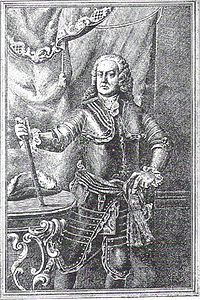Antoni de Villarroel


Antonio de Villarroel y Pelaez (1656, Barcelona – 1726, A Coruña) was a Spanish military commander in the service of Philip V until 1710 in the War of the Spanish Succession. After the disgrace of Philippe II, Duke of Orléans, under whom he served and who plotted to replace Philip V, he switched to the Habsburg cause of Charles VI, keeping his rank. In 1713 he was appointed general commander of the Army of Catalonia.[1]
Military career
He joined the army at a very young age, and in 1697, he defended Barcelona against a French army. At the beginning of the War of Spanish Succession, he fought with the army of Philip V, but the fall from grace of the Duke of Orléans forced him to Galicia where he joined the Allied anti-Borbón league. He was there appointed a deputy marshal for the Archduke Charles VI.
Once in the service of the
Imprisonment and death
Villarroel was imprisoned first in the castle of Alicante and later (1715) in A Coruña, where he died (22 February 1726). He spent his last years confined in a cell that flooded with the rising tide, a circumstance that caused a total paralysis of his two legs.[1] The actual date of his death was discovered by Josep Catà and Antoni Muñoz in 2009. Until then, it was considered that Villarroel had been released from the Alcazar of Segovia following the peace of Vienna and had lived in the pension that would have granted, until his death, the Archduke Charles Emperor of the Holy Roman Empire.
Legacy
A street in the l'Eixample district of modern Barcelona is named after Villarroel.
In the historical novel
References
- Some of the information on this page has been translated from its Spanish Equivalent.
- ^ a b "Què se'n va fer dels herois de la Guerra de Successió?": Sàpiens; núm. 89; març 2010; p. 31; ed. Grup Cultura 03; (In Catalan); ISSN 1695-2014
- ISSN 1695-2014.
- ISBN 978-84-96735-72-9.
